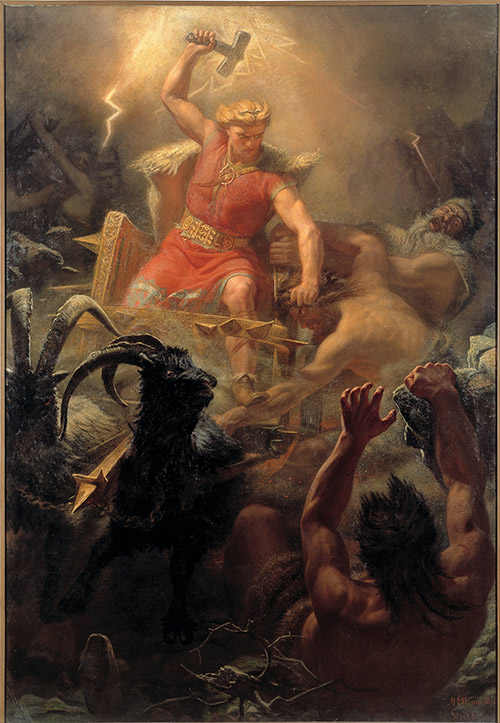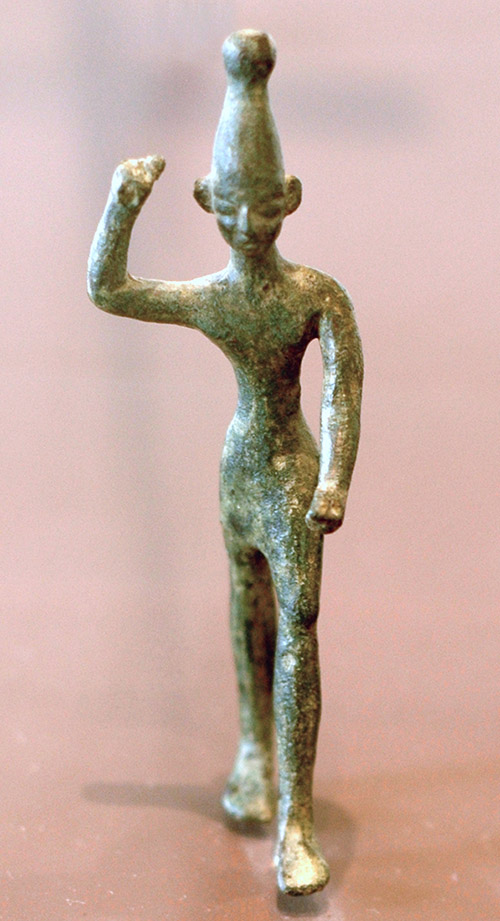People today have weather forecasts to be aware of and prepare for a lightning strike. However, in primitive societies, lightning and thunder were natural phenomena feared for their unpredictability. It was after the establishment of an agricultural society that rain, wind, and thunder transformed into beneficent givers for fertility. Thunderstorm does in fact form nitric acid and nitrous acid gas in the air, which mixes with rain and help fertilize the soil. Despite their lack of knowledge of scientific principles, people in the past would have learned the benefits through experience.
Natural phenomena such as rain, wind, and thunder were commonly considered living gods because of their contribution and agriculture. These gods can also be found in the ancient founding myth of Korea. The legend of Dangun starts with Hwanin (환인), the ruler of the Heavens, and his son Hwanung (환웅). Hwanung descended to earth with the gods of rain, wind, and cloud. He dispensed to his followers such quintessential elements of life including agriculture.
Among the various gods related to natural phenomena, the god of thunder is often worshiped as the god of war in association with the destructivity of lightning. God of thunder is also depicted as a god of earthly fertility and a beneficent giver of life and sustenance.
Gods of Thunder in Mythology of the West
Thor prominently stands out among the gods of thunder. He is the most well-known Norse god in our modern world as the Marvel cinematic series has spurred his fame. He wields his mighty Mjölnir, the legendary hammer with a short handle, which strikes lightning when hit with a stone and turns into a bolt of lightning when thrown. Mölnir always returns to Thor's hands regardless of distance. As a god of strength, he is also associated with the sky, lightning, thunder, storms, and rain. Thor functioned primarily as a protector-god concerning the impact of the natural phenomena on fishing and farming. Hence, he was preferred over his father, Odin, in some regions. The deity of thunder occurs in Old High German as Donar.


Mårten Eskil Winge, 〈Thor's Fight with the Giants〉, 1872
(Thor, the god of thunder, is striking lightning while riding a goat-led carriage)
According to Aztec mythology, the present world was preceded by four other cycles of creation and destruction. Each world began with the creation of a new sun and ended with the destruction of the sun. The third of which is Tlaloc, the god of rain. In Aztec iconography, Tlaloc is painted in blue and is depicted with goggle eyes and snake fangs. He is the creator of water and rain and is also in charge of thunder and lightning. People worshipped Tlaloc as the god of fertility but at the same time feared him. When his wife Xochiquetzal was kidnapped, heartbroken Tlaloc refused to nourish the earth with rain. When people continued to beg for rain, he sent a rain of fire and burnt the entire world to ashes. In the tale of the Five Suns, Tlaloc reigned as the third sun for 312 years which is the shortest among all suns.


Tlaloc in the Aztec pantheon
In Greek mythology, Zeus, the king of the gods, controlled clouds and rain and used lightning as a weapon. Zeus was a god who not only presided over natural phenomena but also maintained the order and justice of the world. In Roman mythology there is Jupiter, a god similar to Zeus. Jupiter is also called Tonans, the Thundering Jove, as he throws lightning and thunder from above like Zeus.
Taranis in Celtic mythology is another god of thunder. This is where the word “taran,” which means thunder in the modern Brittany language, is derived from. Brittany is one of the Celtic languages spoken in Brittany, France. The deity syncretized with Donar of Germani and Jupiter of Rome. He is often depicted with a thunderbolt in one hand and a wheel in the other. The chariot wheel with six or eight spokes, is an important symbol in historical Celtic polytheism.


Taranis in the Celtic mythology
Gods of Thunder in Mythology of the East
Baal, the most famous in Canaan mythology, is the god of rain and fertility. His voice sounds like thunder and with water he makes fertile the harrowed land from his palace above. In the Baal Cycle, Baal secures a thunder mace and a lightning spear from other gods and triumphs in mortal combat with Yam, the god of the seas. Later he was vanquished by Mot, the god of death, because of his challenge out of conceit. Baal is revived when Anath, the goddess of love and war and also his sister and consort, killed Mot out of revenge. With his resurrection, earthly fertility ensued.


A bronze statue of Baal found near the Phoenician coast
In Chinese Taoism, Lei Kung (雷公) is the Duke of Thunder. Deities of heavenly phenomena such as wind, rain, and lightning follow him. He is often depicted with the Yu Shi, the Rain Mater (雨师). In the anthropomorphic depiction, Lei Kung holds a hammer and a mace in human form. When many people were influenced by the Hindu god Garuda in 1000 A.D., Lei Kung was expressed as a bird with a monkey face as well.


Lei Kung the Chinese Daoist deity
In Japan, the deity is called Raijin (雷神, らいじん) and is often depicted with Fujin (風神, ふうじん). Raijin is surrounded by a circle of taiko drums holding his drumsticks that look like dumbbells.


Tawaraya Sotatsu (俵屋宗達), 〈Wind God and Thunder God Screens〉
(Raijin is depicted on the left, Fujin on the right.)
In Korean mythology, the gods take anthropomorphic depiction as ‘General Thunder (벼락장군)’과 ‘General Lightning (번개장군)’ and is also depicted with a bird beak face under the influence of China. It is said that General Thunder and General Lightning punish evil by dropping lightning on the ground.
God of Thunder in Lineage M
Once upon a time, a tribe used to live in Gypsy Town Thundermoor, a land which is located in the northeastern region of Aden Kingdom and has now become desolate. The people of Thundermoor served Adad, the god of thunder. As the tribe believed that those who committed evil deeds would be burned to death by thunder, thunder was worshiped with fear. With this unshakable belief, the tribe was able to use the power of thunder from birth.
Since the beginning of time, Lindvior the Wind Dragon was feared for bringing destruction and disaster. One day, Lindvior realized how the tribe in Gypsy Town is able to use the power of thunder. He was appalled that the uncivilized used similar powers to his own. The fact that the tribe served Adad, who was not on good terms with Lindvior, instead of himself, the lineage of the great god, provoked outrage. Lindvior banished Adad from the temple of Adad and allowed the Cloud Archelemental to take over. He also ordered Torren to invade Thundermoor promising him great powers.


(Left) Torren, (Right) Cloud Archelemental
One day, when the sky hid behind the dark storm clouds, Torren and his corps invaded the quiet peaceful Gypsy Town. Kain and the warriors fought against the invaders but gradually began to lose ground. His friend Rosemary died of serious injury and even trembling old men and children who prayed for their lives were slaughtered. In fury, Kain blazed with every last bit of energy and fought to the finish with Torren until he collapsed. Kain was the sole survivor on the blood-soaked land.


In his dream, Kain found himself in the Plain of Rest where he often visited with his brother and Rosemary in their childhood. He listened closely to Rosemary who urged him to retrieve the temple of Adad occupied by the Cloud Archelemental.
For Kain, everything was burnt down to ashes except his vengeance. The power of lightning strengthened as the uncontrollable fury fueled his natural talent. Kain woke up from the dream and headed straight to the temple of Adad. He repelled the Cloud Archelemental out of the temple and retook the temple.
Just then, the news of Red Knights planning to take down Lindvior the Wind Dragon reached his ears. Kain heads to the Silver Knight Village to wreak vengeance.


“Give me three days.
One day to engrave my rage, the ghastly rage of losing my tribe, at the end of my spear.
Another day to sublimate the sorrow of being left alone into howling thunder.
Last day to take a blood oath with those who will bear the storm of death.
When the days come to a close, I shall punish Lindvior in the name of the god of thunder.”
 Facebook
Facebook  Twitter
Twitter  Reddit
Reddit  LinkedIn
LinkedIn  Email
Email  Copy URL
Copy URL 









